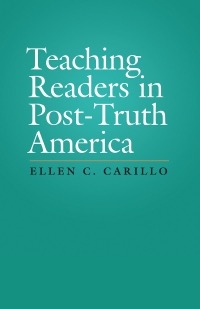
Teaching Readers in Post-Truth America
Date Reviewed: March 21, 2019
Many teachers have had cause in the last few years to ponder questions around teaching in a “post-truth” culture. How do reading, writing, and thinking change in a world in which groups cannot or will not agree on essential facts and rules of evidence? How can we teach meaningful reading in an overwhelmingly information-rich landscape? How can we heal the divisiveness that pervades so much of our culture, and how can we help students discern true from false? This book is written primarily for instructors in first-year college writing courses, but much of it will prove useful to frustrated teachers in any discipline. It does not give many specific recommendations for classroom strategies, but it does set out thoughtful ideas about how to think about teaching reading.
The book begins with a chapter on “theoretical first principles.” Chapter 2 considers the ways in which standardized tests (and teachers in turn) encourage an unthinking reverence for text by dismissing the role of the reader. Carillo provides convincing evidence of negative outcomes from this approach. These two chapters set the stage for an argument in Chapter 3 about reading and writing as embodied, affective acts, as this writer is firmly against the devaluing of emotion and engagement so common in a world that prizes objectivity. In Chapter 4, Carillo argues that modeling and imitation have been given short shrift in reading instruction. She gives several useful tips for developing imitative exercises that help students see good reading and writing practices, and she especially trumpets the power of annotation, illustrated with a case study from her own teaching. The problems highlighted in Chapter 5, specifically targeting writing and composition instruction, are common to other fields as well: focus on reason over emotion; focus on traditional essay forms; and lack of focus on psychological studies that can enhance both teaching and learning.
This book’s title promises more than it delivers, although it delivers a lot. Carillo’s insistence on redirecting students away from claims and argumentation and “toward stylistic elements that contribute to a text’s meaning” (41) will strike many teachers trained in other modes as difficult to attain. “Reading for argument” is, for Carillo, a problem: students only read for a relatively simplistic argument and miss so much that could make them stronger readers, such as inquiring about the how and why, not just the what. Yet many teachers find that students can’t even read for argument, a fact this book glosses over.
That said, a call to encouraging more affective and empathetic reading is timely and needed. The use of Peter Elbow’s doubting and believing game (47-50) will be familiar to many in religious studies, as will the call to look outside one’s own discipline for expertise. This book helps teachers think about ways to mitigate aspects of culture that revere text and steer students “away from the language of negotiation and compromise” (114).